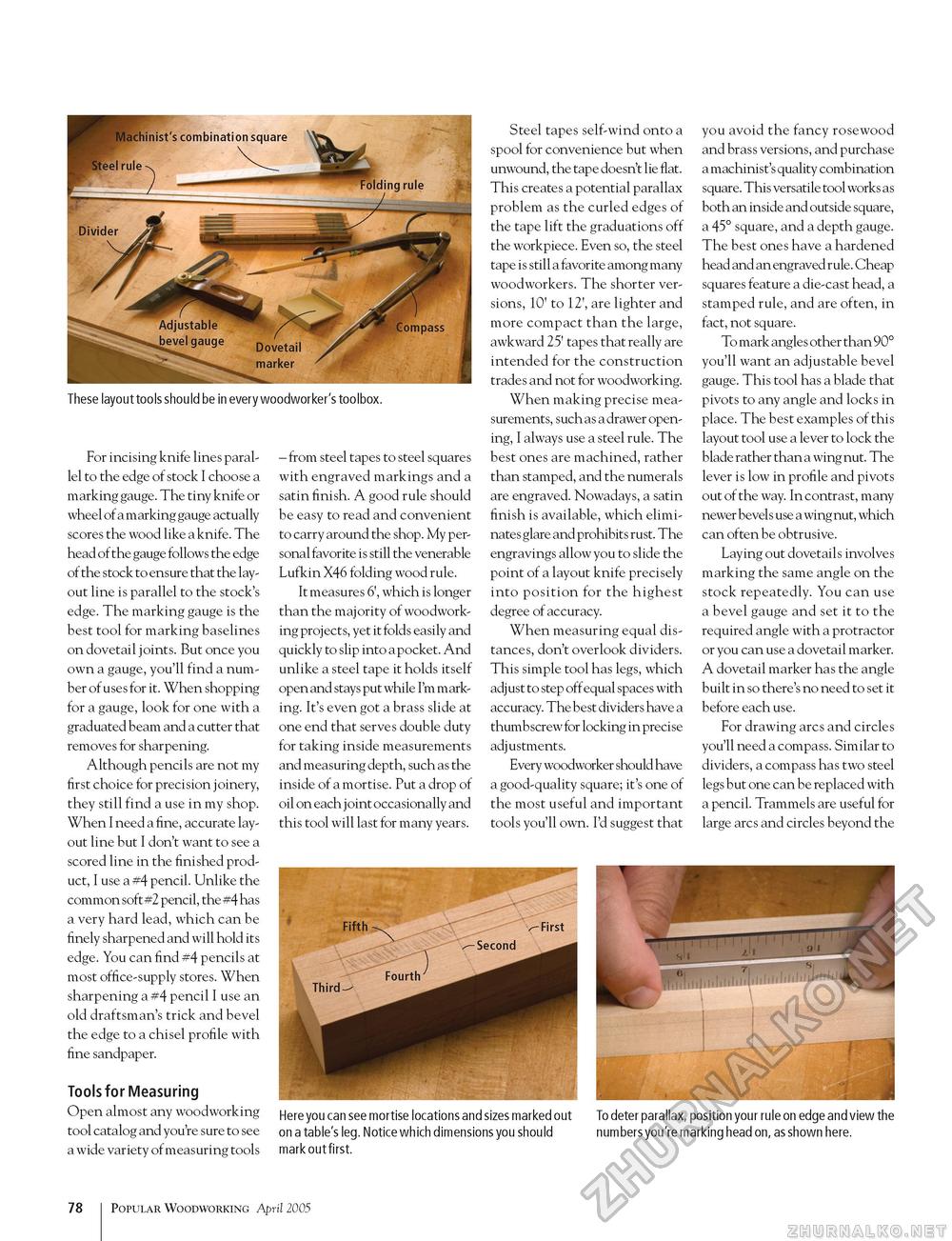Popular Woodworking 2005-04 № 147, страница 81
Machinist's combination square Steel rule These layout tools should be in every woodworker's toolbox. For incising knife lines parallel to the edge of stock I choose a marking gauge. The tiny knife or wheel of a marking gauge actually scores the wood like a knife. The head of the gauge follows the edge of the stock to ensure that the layout line is parallel to the stock's edge. The marking gauge is the best tool for marking baselines on dovetail joints. But once you own a gauge, you'll find a number of uses for it. When shopping for a gauge, look for one with a graduated beam and a cutter that removes for sharpening. Although pencils are not my first choice for precision joinery, they still find a use in my shop. When I need a fine, accurate layout line but I don't want to see a scored line in the finished product, I use a #4 pencil. Unlike the common soft #2 pencil, the #4 has a very hard lead, which can be finely sharpened and will hold its edge. You can find #4 pencils at most office-supply stores. When sharpening a #4 pencil I use an old draftsman's trick and bevel the edge to a chisel profile with fine sandpaper. Tools for Measuring Open almost any woodworking tool catalog and you're sure to see a wide variety of measuring tools - from steel tapes to steel squares with engraved markings and a satin finish. A good rule should be easy to read and convenient to carry around the shop. My personal favorite is still the venerable Lufkin X46 folding wood rule. It measures 6', which is longer than the majority of woodworking projects, yet it folds easily and quickly to slip into a pocket. And unlike a steel tape it holds itself open and stays put while I'm marking. It's even got a brass slide at one end that serves double duty for taking inside measurements and measuring depth, such as the inside of a mortise. Put a drop of oil on each j oint occasionally and this tool will last for many years. Steel tapes self-wind onto a spool for convenience but when unwound, the tape doesn't lie flat. This creates a potential parallax problem as the curled edges of the tape lift the graduations off the workpiece. Even so, the steel tape is still a favorite among many woodworkers. The shorter versions, 10' to 12', are lighter and more compact than the large, awkward 25' tapes that really are intended for the construction trades and not for woodworking. When making precise measurements, such as a drawer opening, I always use a steel rule. The best ones are machined, rather than stamped, and the numerals are engraved. Nowadays, a satin finish is available, which eliminates glare and prohibits rust. The engravings allow you to slide the point of a layout knife precisely into position for the highest degree of accuracy. When measuring equal distances, don't overlook dividers. This simple tool has legs, which adjust to step off equal spaces with accuracy. The best dividers have a thumb screw for locking in precise adjustments. Every woodworker should have a good-quality square; it's one of the most useful and important tools you'll own. I'd suggest that you avoid the fancy rosewood and brass versions, and purchase a machinist's quality combination square. This versatile tool works as both an inside and outside square, a 45° square, and a depth gauge. The best ones have a hardened head and an engraved rule. Cheap squares feature a die-cast head, a stamped rule, and are often, in fact, not square. To mark angles other than 90° you'll want an adjustable bevel gauge. This tool has a blade that pivots to any angle and locks in place. The best examples of this layout tool use a lever to lock the blade rather than a wing nut. The lever is low in profile and pivots out of the way. In contrast, many newer bevels use a wing nut, which can often be obtrusive. Laying out dovetails involves marking the same angle on the stock repeatedly. You can use a bevel gauge and set it to the required angle with a protractor or you can use a dovetail marker. A dovetail marker has the angle built in so there's no need to set it before each use. For drawing arcs and circles you'll need a compass. Similar to dividers, a compass has two steel legs but one can be replaced with a pencil. Trammels are useful for large arcs and circles beyond the Here you can see mortise locations and sizes marked out on a table's leg. Notice which dimensions you should mark out first. To deter parallax, position your rule on edge and view the numbers you're marking head on, as shown here. 78 1 Popular Woodworking April 2005 |








